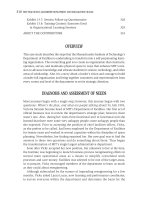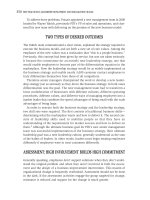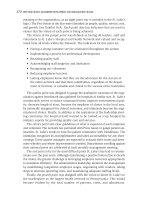Tài liệu Best Practives in Leadership Development & Organization Change 44 pptx
Bạn đang xem bản rút gọn của tài liệu. Xem và tải ngay bản đầy đủ của tài liệu tại đây (155.93 KB, 10 trang )
ABOUT THE CONTRIBUTORS
Andrew Starr is the director of clinical operations for St. Luke’s Hospital. His
primary responsibilities are managing the clinical and business aspects for mul-
tiple departments in the perioperative service line. Prior to his present position,
Andrew was a performance management engineer for Premier, Inc. His respon-
sibilities included department based projects that have resulted in cost savings,
revenue enhancement, and productivity enhancement in both clinical and non-
clinical areas. Andrew also worked in the health/managed care/life sciences
practice of Cap Gemini Ernst & Young. During his two years at CGEY, Andrew
was involved with projects associated with business transformation and health
care package implementation. Andrew also has prior clinical experience as a
dialysis technician. His educational repertoire includes both a master’s degree
in business administration and master’s degree in health services administra-
tion from Xavier University. He also has a bachelor’s degree in biology from the
State University of New York (SUNY) at Oswego.
Robert Zimmel is the senior vice president for human resources for St. Luke’s
Hospital and Health Network. He is responsible for all the human resource func-
tions for the network. Bob has been with St. Luke’s for nineteen years and has
served in various HR roles throughout his career. He is currently a member of the
President’s Council and serves as the chairperson of the leadership steering com-
mittee for the leadership initiative for the network. Bob received his B.S. in busi-
ness from the Indiana University of Pennsylvania and an M.A. in personnel
services and higher education from the Indiana University of Pennsylvania as
well.
Janice Bauer is the assistant vice president of patient care services. Over the
past two years, Jan has served as a leader to multiple units, including the Emer-
gency Department, CCU, ICU, and Trauma Department. Jan has been part of
the organization since 1979 and has served in a variety of positions. Jan’s suc-
cessful growth has included achievement in past positions such as nursing
supervisor, nurse manager, administrative director of emergency services, and
administrative director of trauma.
Margaret Hayn is the assistant vice president of acute care and maternal child
health. Prior to taking on this role, Margaret was the director of woman’s and
children’s service line and continence management program. Prior to these
roles, Margaret also served in a variety of leadership roles during a fifteen-year
tenure at St. Luke’s Hospital. Margaret has been involved in nursing for nearly
thirty years. Her distinguished academic record includes a master’s degree in
nursing and in family practice. She also holds a bachelor’s of nursing from
400
BEST PRACTICES IN LEADERSHIP DEVELOPMENT AND ORGANIZATION CHANGE
cart_14399_ch16.qxd 10/19/04 1:19 PM Page 400
Columbia University. Margaret is published in numerous journals and has
served as a guest speaker and lecturer in many academic and hospital forums.
Carol Kuplen is the vice president, senior nurse executive for St. Luke’s Hos-
pital and Health Network. Carol’s primary responsibility includes providing
administrative oversight of nursing services for a five-hospital, nonprofit, inte-
grated health care network. Other responsibilities include developing and imple-
menting nursing leadership philosophy, identifying outcome expectations,
leading recruitment and retention initiatives, and facilitating the redesign of
nursing care delivery systems. Prior to her present position, Carol successfully
served in other capacities within St. Luke’s, including director of the Cancer
Network. Mrs. Kuplen has also worked in various positions at other prestigious
hospitals, including Georgetown University Medical Center and Geisinger
Wyoming Valley Medical Center. Her educational repertoire includes M.S. in
nursing from the University of Pennsylvania and a B.S in nursing from
Georgetown University.
Bob Weigand is the director of management training and development for
St. Luke’s Hospital and Health Network. He is responsible for designing, devel-
oping, implementing, and evaluating leadership development programs through-
out the network. Weigand incorporates experiential learning into his training
curriculum. He has published articles and contributed to three books on the
topic of training evaluation. Weigand is certified in the Myers Briggs Type Inven-
tory. He currently is on the faculty of several local colleges, where he teaches
part time. Weigand was previously employed at the Reading Hospital, where his
work included working with family practice residents on communication skills.
He received his B.A. in psychology from Ricker College in Houlton, Maine, and
a master’s in psychology from Assumption College in Worcester, Massachusetts.
Debra Klepeiss currently functions in the role of senior hospital director, oper-
ations and service management at St. Luke’s Allentown Campus. She has been
employed by St. Luke’s Hospital and Health Network for twenty-eight years.
Over that time span Debra has been in many different roles, encompassing staff
nursing, nursing management, human resources management, performance
improvement, accreditation and compliance, organizational development, edu-
cation, leadership development, service improvement, and patient satisfaction.
Klepeiss is a RN and has a human resources certificate, and a B.A. in business
management.
Lisa Dutterer has been the vice president for ambulatory and ancillary services
for St. Luke’s Hospital Allentown Campus since January 2001. Lisa is responsi-
ble for all the outpatient services at the campus in addition to the allied health
services that support the care of the inpatient. Prior to her current position, she
ST. LUKE’S HOSPITAL AND HEALTH NETWORK
401
cart_14399_ch16.qxd 10/19/04 1:19 PM Page 401
was administrative director for the inpatient and outpatient rehabilitation
services at the hospital of the University of Pennsylvania Medical Center
and Presbyterian Medical Center. Lisa’s career in health care started as a
licensed physical therapist at Germantown Hospital in Philadelphia. She
received her B.A. in biology from Bridgewater College in 1988 and an M.S. in
physical therapy from Arcadia University in 1991.
Sherry Rex is the director of human resources at St. Luke’s Quakertown Hos-
pital. Prior to joining St. Luke’s, she served as the manager of benefits and com-
pensation at The Morning Call, a subsidiary of Tribune Publishing. She was also
the payroll manager for the CoOpportunity Center, a shared services center for
Times Mirror, the prior parent company of The Morning Call. Sherry also served
as the human resources and operations manager for the Bon-Ton Department
Stores. Following her graduation from college, she completed the executive train-
ing program for Boscov’s Department Stores. Sherry is a graduate of Widener
University, where she earned a bachelor’s degree in arts and sciences.
John Hrubenek is director of property management, St. Luke’s Hospital and
Health Network. Prior to that position he was the director of support services.
He holds a bachelor’s degree in economics and business from Lafayette College
and a master’s in business administration from Lehigh University.
Donna Sabol is the assistant vice president of network performance improve-
ment for St. Luke’s Hospital and Health Network. Prior to her present position,
Donna served in various positions within the health network, including direc-
tor of organizational development. Donna has been associated with St. Luke’s
for twenty years. She is an RN and holds an M.S. in nursing from DeSales
University and a B.S. in nursing from Wilkes University.
Additional thanks to Francine Botek, Gary Guidetti, Ellen Novatnack, Steven
Schweon, Charlotte Becker, Howard Cook, and Joe Pinto.
402
BEST PRACTICES IN LEADERSHIP DEVELOPMENT AND ORGANIZATION CHANGE
cart_14399_ch16.qxd 10/19/04 1:19 PM Page 402
CHAPTER SEVENTEEN
StorageTek
Aiming for a high-performance culture led StorageTek to develop a
transformation plan that balanced traditional operational management
with the innovation required to be competitive in the information
technology industry. A key element of the plan is successfully coordinating
initiatives already embedded in the organization and supplementing
those initiatives with new thinking.
OVERVIEW 404
INTRODUCTION 404
A New Chairman Confronts the Issues 406
DEFINE THE CHALLENGE 406
Figure 17.1: Phases of Transformation 407
Define the Goal 408
Figure 17.2: Definition of High-Performance Culture 408
Figure 17.3: Alignment to Build a High-Performance Culture 409
Create a Sense of Urgency 410
Lessons Learned 411
WORK THROUGH CHANGE 411
Focus on Results and Defining Expectations 412
Table 17.1: Performance Measurement (Spring 2002) 413
Improve Management Competency 414
Grow Organizational Capabilities 415
Figure 17.4: Transforming on Three Levels 416
Lessons Learned 417
ATTAIN AND SUSTAIN IMPROVEMENT 418
Figure 17.5: StorageTek Timeline of Organization Transformation 419
STORAGETEK: THE HIGH-PERFORMANCE ORGANIZATION 420
Exhibit 17.1: Summary of Lessons Learned 421
403
S
S
cart_14399_ch17.qxd 10/19/04 1:18 PM Page 403
REFERENCES 422
ABOUT THE CONTRIBUTOR 422
OVERVIEW
This change management case study describes the approach used by StorageTek
to develop and implement a transformational plan to establish the company as
a high-performance leader in the information technology (IT) industry. After a
series of ups and downs in its thirty-four year history, StorageTek® (Storage
Technology Corp., NYSE:STK), during the later years of the 1990s and into the
early years of 2000, was once again in a state of unbalance between operational
management and the innovation required to be competitive. Steps were taken
to turn the company around, but there was little improvement. StorageTek lead-
ership recognized the need for a systematic plan to transform the company into
a high-performance organization.
The transformation plan outlined the steps to be taken in three stages. Using
best-practices research, StorageTek defined the high-performance organization
and the leadership model required to implement the plan. Both focused on
results in a competent and open, trusting environment. The second stage
required working through the change by creating a focus on results, defining
individual expectations, improving management competencies, and growing
organizational capabilities. Specific to this stage were improvements to perfor-
mance management systems, communications, customer relationships, and
many other areas. The third stage of attaining and sustaining improvement is
under way.
In light of the economic downturn worldwide, the challenge was to continue
to follow the transformation plan. Lessons learned are applicable to other orga-
nizations beginning a major transformation or analyzing and implementing
corrections to the current path.
INTRODUCTION
Four IBM engineers with a dream of building better and less expensive tape dri-
ves for data storage founded StorageTek in Boulder, Colorado, in 1969. Today,
StorageTek is a $2 billion worldwide company with headquarters in Louisville,
Colorado, and an innovator and global leader in virtual storage solutions for tape
automation, disk storage systems, and storage networking. The StorageTek head-
quarters is about halfway between Denver and Boulder, Colorado, on a 450-acre
campus in the shadow of the Rocky Mountains. Of the approximately
404
BEST PRACTICES IN LEADERSHIP DEVELOPMENT AND ORGANIZATION CHANGE
cart_14399_ch17.qxd 10/19/04 1:18 PM Page 404









